At a United Nations General Assembly meeting on Sept. 21, the first ever called only to discuss drug-resistant bacteria, U.N. Secretary General Ban Ki-moon stated that antimicrobial resistance is a “fundamental threat” to global health and safety.
“If we fail to address this problem quickly and comprehensively, antimicrobial resistance will make providing high-quality universal healthcare coverage more difficult if not impossible,” Ban said during the General Assembly. “It will undermine sustainable food production. And it will put the Sustainable Development Goals in jeopardy,” he said.
Estimates suggest that about 700,000 people die each year due to drug-resistant infections. However, this number could be higher, since there is no global protocol for reporting and recording these deaths.
Scientists have known the potential threat of resistant bacteria for almost half a century. One of the first people to warn the world was Alexander Fleming, who created the first antibiotic, penicillin, in 1928. He cautioned the world about drug-resistant bacteria threat while receiving the Nobel Prize in 1945.
“There is the danger that the ignorant man may easily underdose himself and, by exposing his microbes to nonlethal quantities of the drug, make them resistant,” Fleming said during his Nobel lecture.
While superbugs have been gaining more attention recently, scientists have been searching for new ways to fight bacteria without causing them to mutate and start resisting for over a decade.
Engineers and physicians at the University of Melbourne have engineered tiny, star-shaped peptide polymers that not only can kill bacteria that are resistant to current antibiotics, but also avoid causing bacteria to mutate into superbugs.
The team consisted of Professor Greg Qiao and Shu Lam, a graduate student from the University of Melbourne’s Department of Chemical and Biomolecular Engineering. They also worked with Associate Professor Neil O’Brien-Simpson and Professor Eric Reynolds from the Faculty of Medicine, Dentistry and Health Sciences and Bio21 Institute.
The team has been working with peptide polymers for the past few years and only recently foresaw the potential application of the polymers in fighting bacteria. The star-shaped polymers that the team is currently developing were extremely effective in killing Gram-negative bacteria, the major class of bacteria known to be prone to mutation and drug resistance.
These polymers have the ability to kill bacteria on multiple fronts. They work not only chemically, but also by ripping apart the bacteria’s cell wall, whereas most antibiotics fight bacteria in only one way. Additionally the team found that their star-shaped polymers are safe for clinical use and that a 100 times larger dose would be needed to cause any damage to blood cells.
The team has confirmed the effectiveness of their star-shaped polymers in animal models. Professor Qiao believes that their discovery is the revelation of a new avenue of fighting superbugs.





